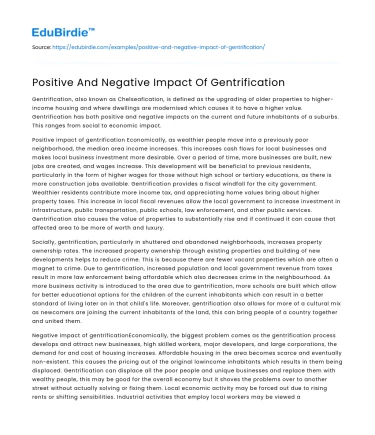Gentrification, also known as Chelseafication, is defined as the upgrading of older properties to higher-income housing and where dwellings are modernised which causes it to have a higher value. Gentrification has both positive and negative impacts on the current and future inhabitants of a suburbs. This ranges from social to economic impact.
Positive impact of gentrification Economically, as wealthier people move into a previously poor neighborhood, the median area income increases. This increases cash flows for local businesses and makes local business investment more desirable. Over a period of time, more businesses are built, new jobs are created, and wages increase. This development will be beneficial to previous residents, particularly in the form of higher wages for those without high school or tertiary educations, as there is more construction jobs available. Gentrification provides a fiscal windfall for the city government. Wealthier residents contribute more income tax, and appreciating home values bring about higher property taxes. This increase in local fiscal revenues allow the local government to increase investment in infrastructure, public transportation, public schools, law enforcement, and other public services. Gentrification also causes the value of properties to substantially rise and if continued it can cause that affected area to be more of worth and luxury.
Save your time!
We can take care of your essay
- Proper editing and formatting
- Free revision, title page, and bibliography
- Flexible prices and money-back guarantee
Socially, gentrification, particularly in shuttered and abandoned neighborhoods, increases property ownership rates. The increased property ownership through existing properties and building of new developments helps to reduce crime. This is because there are fewer vacant properties which are often a magnet to crime. Due to gentrification, increased population and local government revenue from taxes result in more law enforcement being affordable which also decreases crime in the neighbourhood. As more business activity is introduced to the area due to gentrification, more schools are built which allow for better educational options for the children of the current inhabitants which can result in a better standard of living later on in that child's life. Moreover, gentrification also allows for more of a cultural mix as newcomers are joining the current inhabitants of the land, this can bring people of a country together and united them.
Negative impact of gentrificationEconomically, the biggest problem comes as the gentrification process develops and attract new businesses, high skilled workers, major developers, and large corporations, the demand for and cost of housing increases. Affordable housing in the area becomes scarce and eventually non-existent. This causes the pricing out of the original lowincome inhabitants which results in them being displaced. Gentrification can displace all the poor people and unique businesses and replace them with wealthy people, this may be good for the overall economy but it shoves the problems over to another street without actually solving or fixing them. Local economic activity may be forced out due to rising rents or shifting sensibilities. Industrial activities that employ local workers may be viewed as a nuisance or environmental hazard by new arrivals. Local shops may lose their leases under pressure from posh boutiques and restaurants.
Socially, resentment emerges within the community and conflict can occur between the original inhabitants and the middle class gentrifiers. Opposition to gentrification can reflect fear of community change. Many urban neighborhoods have distinct cultural identities and strong connections among local friends, businesses, and institutions. Many residents greatly value these relationships and fear that they will be spoiled by newcomers who misunderstand or even ridicule their traditions. When these things are lost due to the displacement of these people, it can even be hazardous to their health. Studies found that hospitalization rates for mental illness - including schizophrenia and mood disorders - are two times as high in displaced people versus those who remain in their neighborhood. Neighborhood change is often viewed as a miscarriage of social justice, in which wealthy, typically white, newcomers are congratulated for 'improving' a neighborhood whose poor, minority residents (usually of colour) are displaced. These new buildings are usually intended for upper-income families which can be socially problematic as they disproportionately exclude people of colour and low-income individuals. Furthermore, because of the potential for large profits from the conversion of ordinary living spaces to highrise or office buildings, many landlords often use immoral means to intentionally displace lowincome residents from rent-controlled areas.
Many people (mostly the rich newcomers) will say gentrification is beneficial and many (mostly the low income current inhabitants) will say its detrimental. However, in conclusion, we notice that gentrification actually has both positive impacts and negative impacts on the current and future inhabitants of a suburb, socially and economically.






 Stuck on your essay?
Stuck on your essay?

